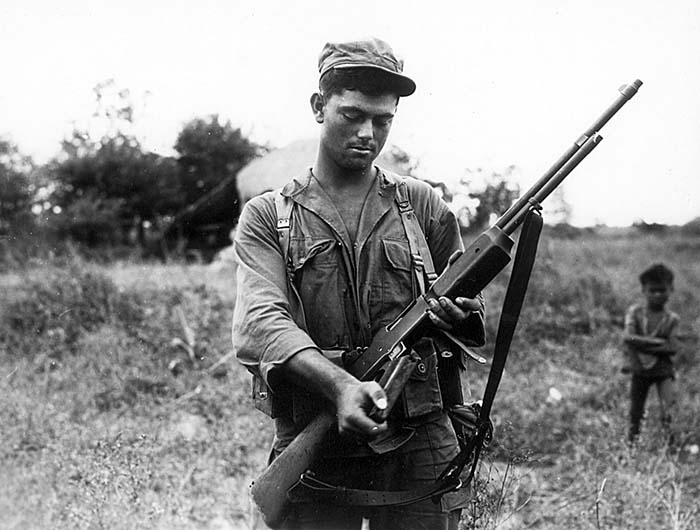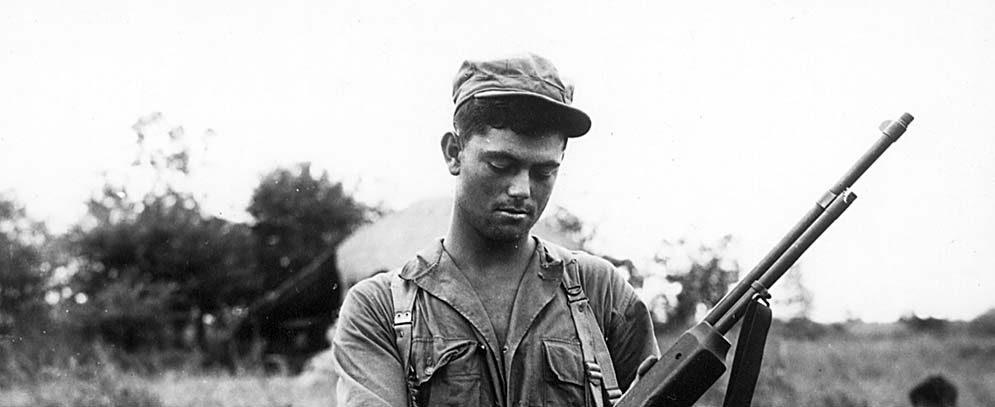By Lt. James Ballou
The Marine Corps – Rock in a Hard Place
More than any other branch of the military, the Marine Corps from early on grasped the potential of the B.A.R. They realized that it could provide the mobile firepower that can turn the tide of battle. Such American heroes as Meritt Evans, Carson and Lewis “Chesty” Puller experi-mented with the B.A.R.’s potential. Blood-ied from battles in Haiti and Nicaragua, the Marine Corps evolved thirteen man squads, consisting of three fire teams of four men. One platoon contained three squads and three platoons made up a com-pany
The Corps increased the number of B.A.R.’s in a Division from the 513 to 867. For me, a ten year old in 1952, Sun-day afternoon at 1:00 PM was special. I eagerly awaited those stirring sounds of Ri-chard Roger’s theme to Victory at Sea. This award winning series offered the best in documentary film of WWII and I searched each frame for a glimpse of a B.A.R. Episode 18, “Two if by Sea” had the best BAR combat photos I had ever seen. Little did I know that fifty years later I was to write a comprehensive book on this rifle.
In all the film clips, the Marines were employing the BAR just as John Moses Browning had conceived it, as an auto-matic rifle. By the latter part of the Pacific the-ater, the BAR had returned to its roots. Gone were the doodads created by Spring-field Armory to turn the Automatic rifle into a crew served squad automatic weapon. Gone were the bipods, carrying handles and flash hiders. The road to the 1918 A2 BAR is well documented in the “Schroder Report” dated, September 12, 1945 by Captain Charles E. Schroder, from the 1918 to 1918
A 1 and eventually in February, 1939 to the 1918 A2. The additions included a muzzle mounted bipod, shortened forend, hinged buttplate, a monopod, magazine guide and a rate reducer. All of these neat innova-tions were developed by Springfield Ar-mory to produce a crew served light ma-chine gun, a squad automatic weapon now known by the acronym SAW.
Another useful add-on was the T-4 carrying handle adopted September 21, 1944. This had some merit and did avert many a burned finger.
All of these modifications not only changed the characteristics of the weapon, but also raised the weight from 16 pounds to 19.4 pounds. That extra 3.4 pounds can feel like 34 in the jungles, so it’s not sur-prising that the bipods and floppy carry-ing handles rapidly dissolved into the fes-tering jungle.
The film clearly shows the Marines firing the BAR as an automatic rifle from their shoulders on their own two feet like a “man”. The 30/06 fired from the BAR would tear through the tops of palm trees to topple the enemy like “rag dolls”, and to blast through the palm trunk reinforce-ment of a bunker. Tracer fire not only il-luminated the trajectory but would set alight ammo dumps and annihilate the en-emy where he stood.
“Victory at Sea” was hard won with the hard hitting rock of the BAR. Truly a, Rock in a Hard Place.

Material gleaned from my book
Rock in a Hard Place
Collector Grade Publications, Inc.
PO Box 1046
Cobourg, Ontario
Canada K9A-4W4
| This article first appeared in Small Arms Review V4N3 (December 2000) |











